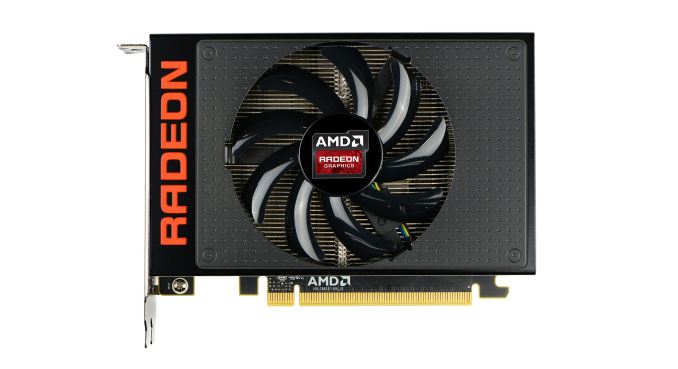AMD Cuts Price of Radeon R9 Nano to $499
by Ryan Smith on January 11, 2016 7:35 AM EST
Word comes from AMD via a press release this morning that they are giving the Radeon R9 Nano a price cut. AMD’s diminutive flagship, which launched in September 2015 at $649, is now the first Fiji card to get an official price cut, with AMD lowering the MSRP to $499 effective immediately.
The third card based on AMD’s flagship Fiji GPU, the Radeon R9 Nano was in a sense a culmination of AMD’s design goals for Fiji. Seeking to take full advantage of the compact packaging afforded by the use of High Bandwidth Memory, AMD packed a fully enabled Fiji into a Mini-ITX sized video card designed especially for small form factor systems. The resulting card was neither a performance flagship card like the Fury X nor a clear second-tier card like the regular Fury, but rather a third card that occupied its own niche within the PC market. This coupled with its unique power binning requirements led to it being launched as a micro-sized alternative to the full Fury X at the same $649 MSRP.
This marks the first instance of a significant price cut for a Fiji card – since their respective launches we’ve seen all three cards drift lower by only $50 or so – and that the card receiving a price drop is AMD’s most recently launched Fiji card is a bit surprising. From a price/performance perspective the Nano was essentially priced as a luxury card, with AMD banking on being able to charge a premium for its improved power efficiency and small size. Today’s price drop essentially puts an end to that, especially since the two Fury cards are not receiving a price cut of their own. With that said, the Nano’s power requirements call for what is arguably the best Fiji chip bin, so that adds another wrinkle to the entire situation.
More interesting perhaps is where this puts the R9 Fury (vanilla), which can already be found for as low at $499. The R9 Fury is only a few percent faster than the R9 Nano and noticeably more power hungry as well, so if the R9 Fury remains at $499 then it's hard to imagine the R9 Nano not being disruptive to R9 Fury sales.
Finally, it’s also worth noting that this comes just days after NVIDIA’s most recent game bundle announcement. Although not specifically addressed by AMD, this may be their response to that bundle in order to shore up their lineup against the similarly-priced GTX 980. Especially since this now places AMD's most power efficient card against NVIDIA's most efficient card, offering about 5% better performance for 5% higher power consumption.
| Winter 2016 GPU Pricing Comparison | |||||
| AMD | Price | NVIDIA | |||
| $629 | GeForce GTX 980 Ti | ||||
| Radeon R9 Fury X | $599 | ||||
| Radeon R9 Fury Radeon R9 Nano |
$499 | ||||
| $479 | GeForce GTX 980 | ||||
| Radeon R9 390X | $379 | ||||
| Radeon R9 390 | $299 | GeForce GTX 970 | |||










74 Comments
View All Comments
jragonsoul - Monday, January 11, 2016 - link
Yeah you are very wrong if you think the 970 comes CLOSE to the Nano. As stated it's more a contender with the 980 and most of the times wins verse's it.Oxford Guy - Wednesday, January 13, 2016 - link
The 970 is a super card that can do anything!Cygni - Monday, January 11, 2016 - link
Videocard pricing is not linear at the high end. A $1000 card is very very very rarely faster than a $500 card in regular workloads. You're paying to be on the bleeding edge, this is not really a cost/performance realm.Cygni - Monday, January 11, 2016 - link
Meant 2x as fast.godrilla - Monday, January 11, 2016 - link
True but when you get more performance % than cost % its a must buy. 980 ti vs 980 was a 40% jump for me 35% price but 40% performance advantage. The non reference 980 ti $50 premium got you another 20% performance gain.just4U - Wednesday, January 13, 2016 - link
At a $600 launch price here in Canada (now $750 with our low dollar..) I'd have been a little choked pulling the trigger on a 980 early with the ti variant being so much better. Today? Not so much as most 980Ti's here come in at 930-$1200 which I simply couldn't justify spending anyway.Ch4os - Tuesday, January 19, 2016 - link
"but for the longevity that performance offers, which eventually destroys AMD in price to performance ratio after a few years of ownership."Funny you should say that. Where's Kepler when compared to GCN cards? Oh yeah. Below all of their GCN rivals.
https://tpucdn.com/reviews/ASUS/R9_380X_Strix/imag...
beginner99 - Monday, January 11, 2016 - link
Probably means sales are lower than expected and they probably want to sell most of the inventory before Polaris comes out in Summer.BrokenCrayons - Monday, January 11, 2016 - link
You're probably right. With new GPUs on a new process node looming, clearing inventory by cutting prices now will clear the retail channel for newer cards. It's better for AMD to cut prices to a level the company can tolerate than take a much larger loss later by failing to manage the market.eldakka - Tuesday, January 12, 2016 - link
I was actually thinking that it might be an indication that they are getting better than expected yields, such that they can bin more nano-capable chips that can support a higher demand.